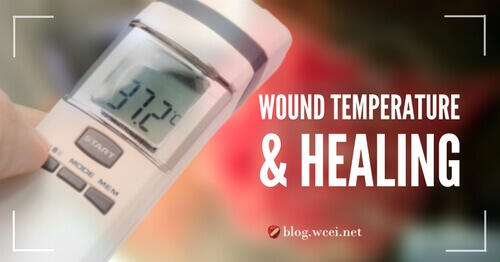You’ve probably heard that it’s important to keep wounds moist and warm, But what’s the optimal temperature for healing a wound, and how do you maintain it? Read on for details.
When moisture evaporates from a surface, the surface cools. Sweat operates by this principle. So, unfortunately, do wounds. Whenever a wound loses moisture, the tissues of the wound drop in temperature.
The cells and enzymes of the body function best at normal temperature, around 37° C (98.6° F). When wound temperature decreases by as little as 2° C, healing can slow or even cease. In short, when the temperature drops, the healing stops.
Furthermore, cooled tissues cause vasoconstriction and increase hemoglobin’s need for oxygen. As a result, there’s less oxygen available for the type of white blood cells called neutrophils to fight any potential infection.
Here’s the kicker: once the wound tissues cool– such as when left open to air during a dressing change– the wound base can take up to 4 hours to return to normal healing temperature. If a clinician changes a dressing TID, the wound may be outside of the optimal healing range 50% of the time!
Dressings and Wound Temperature
As we develop treatment plans, we want to keep the wound warmly dressed and reduce opportunities to lose moisture and heat. To accomplish this, we can use more insulating dressings that have the technology to stay in place for longer periods of time.
In one wound dressing study, investigators measured the temperature of the wound base when covered by different types of dressings.
- Air exposed – 21° C (69° F)
- Gauze covered – 26° C (78.8° F)
- Film covered – 31° C (87.8° F)
- Foam covered – 34° C (93.2° F)
Polyurethane Foam, as you can see, is the warmest dressing, while gauze offers much less wound insulation. Meanwhile, foam dressings can often stay in place from 3 to 7 days (depending on manufacturer’s instructions). Changing dressing less frequently not only keeps the wound consistently warmer, it reduces labor, materials, and exposure to contaminants. In fact, modern dressings that help maintain optimal temperature and moisture can be much more economical than traditional gauze dressings.
It goes without saying that letting chronic wounds “breathe” isn’t helpful. Obviously, you need to uncover the wound for dressing changes, assessment, debridement and other treatments. But “airing out” a wound is just another word for releasing moisture and heat. Next time you see a clinician leaving a chronic wound open to air, educate them on modern wound care.
What’s Your Experience?
So tell us, are you considering this variable when caring for your patients? Is everyone on your team on board? What are your favorite dressings for keeping wounds in the optimal temperature range? We’d love to hear from you. Please leave your comments below.
Wound Care Education Institute® provides online and onsite courses in Skin & Wound, Diabetic and Ostomy Management. Eligible clinicians may sit for the prestigious WCC®, DWC® and OMS national board certification exams through the National Alliance of Wound Care and Ostomy®(NAWCO®). For details, see wcei.net.
DISCLAIMER: All clinical recommendations are intended to assist with determining the appropriate wound therapy for the patient. Responsibility for final decisions and actions related to care of specific patients shall remain the obligation of the institution, its staff, and the patients’ attending physicians. Nothing in this information shall be deemed to constitute the providing of medical care or the diagnosis of any medical condition. Individuals should contact their healthcare providers for medical-related information.
What do you think?

